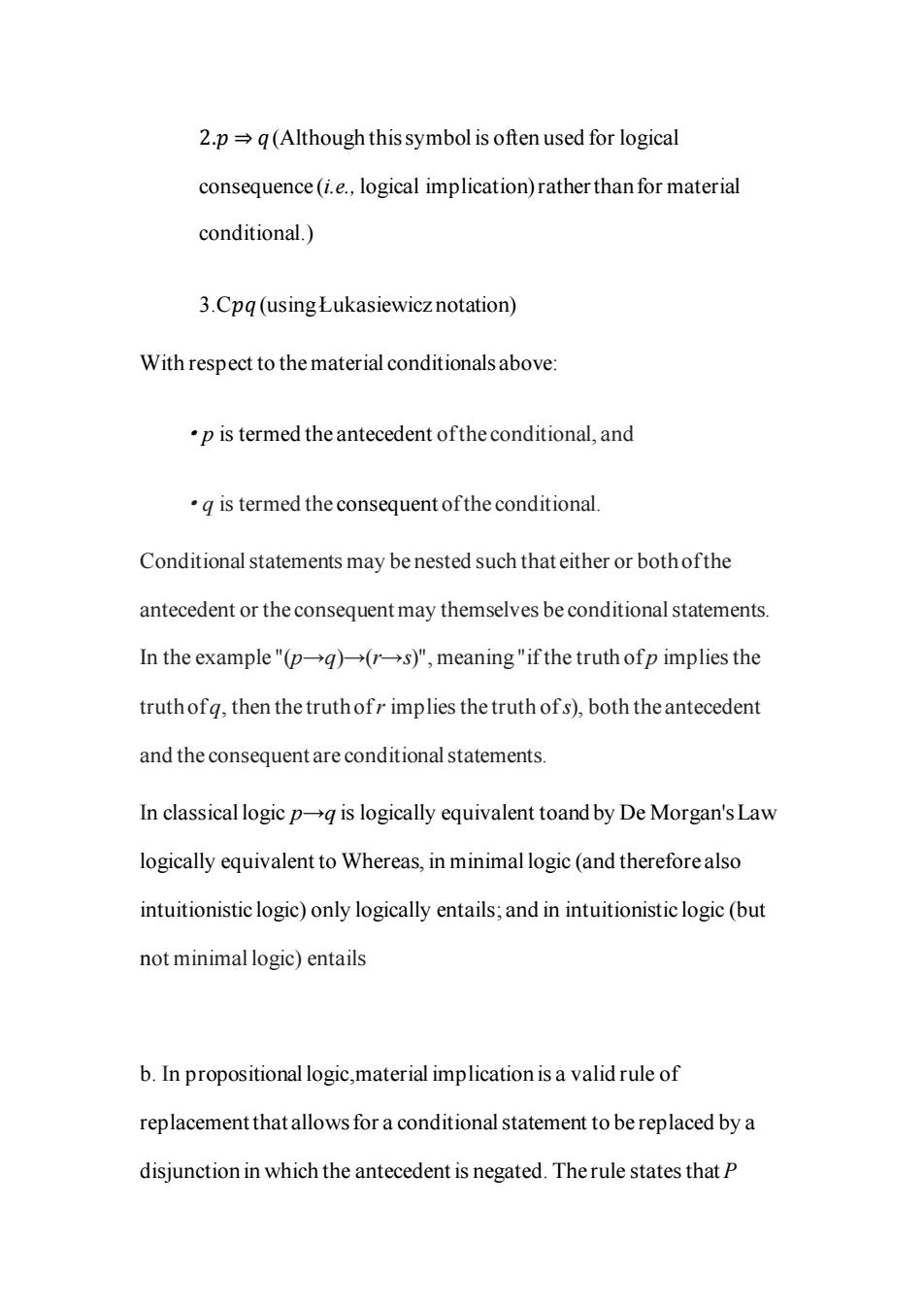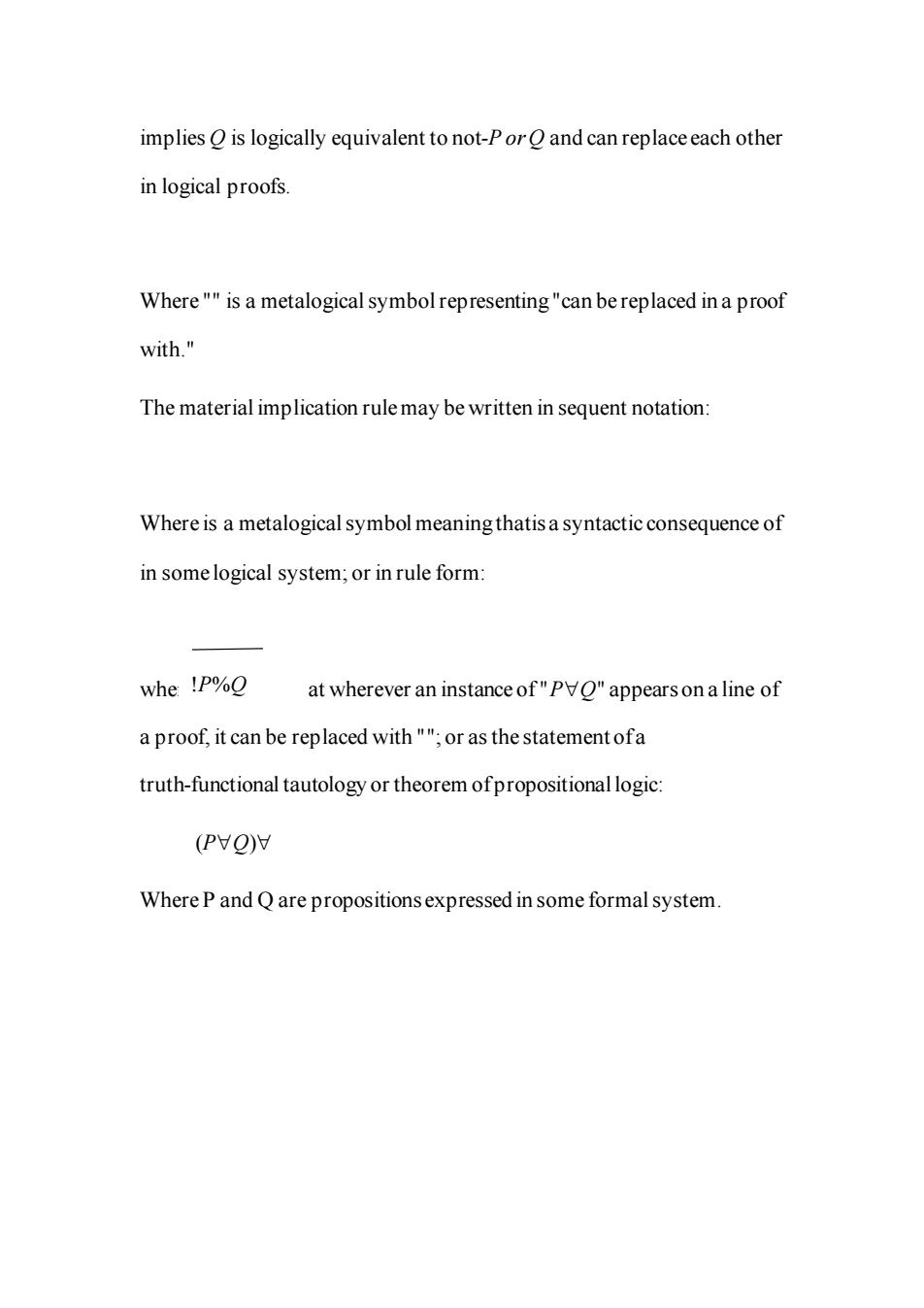
Material implication may refer to: a.Material conditional,a logical connective b.Material implication(rule ofinference),a rule ofreplacement for some propositional logic a.The material conditional(also known as material implication,material consequence,or simply implication,implies,or conditional)is a logical connective(or a binary operator)that is often symbolized by a forward arrow "V".The material conditional is used to form statements ofthe form pg(termed a conditional statement)which is read as"if p then g" Unlike the English construction"if...then..",the material conditional statement p doesnot specify acausal relationship betweenpandq.It is merely to be understood to mean"ifp is true,then g is also true"such that thestatementp is falseonly whenp is trueand g is false.The material conditional only states that g is true when(but not necessarily only when)p is true,and makes no claim that p causes g The material conditional is also symbolized using: 1.pq(Althoughthis symbol may beused for the superset symbol in set theory.)
Material implication may refer to: a. Material conditional, a logical connective b. Material implication (rule of inference), a rule of replacement for some propositional logic a. Thematerial conditional(also known as material implication, material consequence, or simply implication,implies, or conditional) is a logical connective (or a binary operator) that is often symbolized by a forward arrow "". The material conditional is used to form statements of the form p→q (termed a conditional statement) which is read as "if p then q". Unlike the English construction "if...then...", the material conditional statement p→q does not specify a causal relationship between p and q. It is merely to be understood to mean "if p is true, then q is also true" such that the statement p→q is false only when p is true and q is false. The material conditional only states that q is true when (but not necessarily only when) p is true, and makes no claim that p causes q. The material conditional is also symbolized using: 1.𝑝 ⊃𝑞 (Although this symbol may be used for the superset symbol in set theory.);

2.pq(Although this symbol is often used for logical consequence(i.e.,logical implication)rather than for material conditional.) 3.Cpq(using Lukasiewicznotation) With respect to the material conditionals above: "p is termed the antecedent ofthe conditional,and g is termed the consequent ofthe conditional Conditional statements may be nested such that either or bothofthe antecedent or the consequent may themselves be conditional statements. In the example"(p→q)→(r一→s)",meaning"'ifthe truth ofp implies the truthofg,then the truthofr implies the truth ofs),both the antecedent and the consequent are conditional statements. In classical logic p-q is logically equivalent toand by De Morgan's Law logically equivalent to Whereas,in minimal logic(and thereforealso intuitionistic logic)only logically entails;and in intuitionistic logic (but not minimal logic)entails b.In propositional logic,material implication is a valid rule of replacement that allows for a conditional statement to be replaced by a disjunction in which the antecedent is negated.Therule states that P
2.𝑝 ⇒ 𝑞 (Although this symbol is often used for logical consequence (i.e., logical implication) rather than for material conditional.) 3.C𝑝𝑞 (usingŁukasiewicz notation) With respect to the material conditionals above: ·p is termed the antecedent of the conditional, and ·q is termed the consequent of the conditional. Conditional statements may be nested such that either or both of the antecedent or the consequent may themselves be conditional statements. In the example "(p→q)→(r→s)", meaning "if the truth of p implies the truth of q, then the truth ofr implies the truth ofs), both the antecedent and the consequent are conditional statements. In classical logic p→q is logically equivalent toand by De Morgan's Law logically equivalent to Whereas, in minimal logic (and therefore also intuitionistic logic) only logically entails; and in intuitionistic logic (but not minimal logic) entails b. In propositional logic,material implication is a valid rule of replacement that allows for a conditional statement to be replaced by a disjunction in which the antecedent is negated. The rule states that P

implies is logically equivalent to not-Por and can replaceeach other in logical proofs. Where""is a metalogical symbolrepresenting"can be replaced in a proof with." The material implication rule may be written in sequent notation: Where is a metalogical symbol meaning thatis a syntactic consequence of in some logical system;or in rule form: whe !p%0 at wherever an instance of"PVO"appears on a line of a proof,it can be replaced with"";or as the statementofa truth-functional tautology or theorem ofpropositional logic: (PVO) Where P and Q are propositionsexpressed in some formal system
implies Q is logically equivalent to not-P or Q and can replace each other in logical proofs. Where "" is a metalogicalsymbolrepresenting "can be replaced in a proof with." The material implication rule may be written in sequent notation: Where is a metalogical symbol meaning thatis a syntactic consequence of in some logical system; or in rule form: where the rule is that wherever an instance of "PQ" appears on a line of a proof, it can be replaced with ""; or as the statement of a truth-functional tautology or theorem of propositional logic: (PQ) Where P and Q are propositions expressed in some formal system. PQ